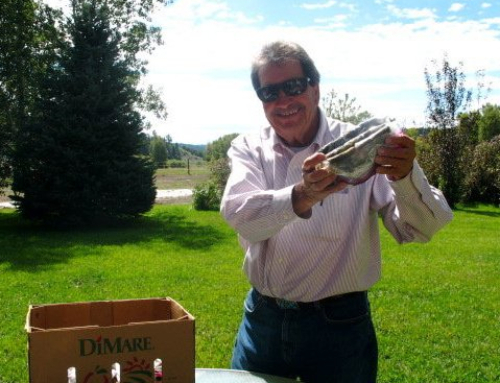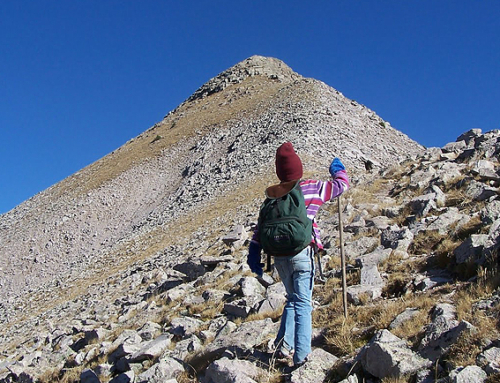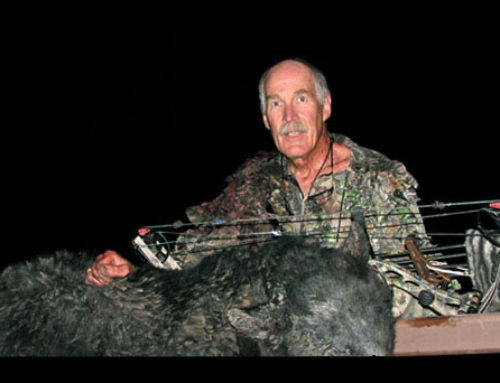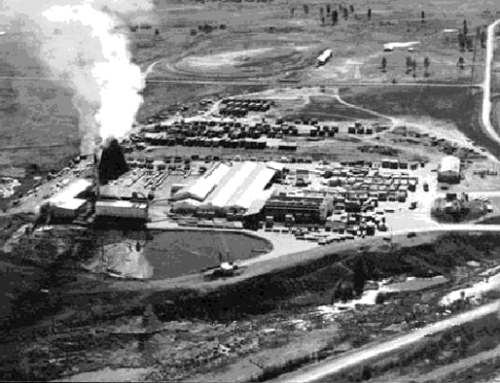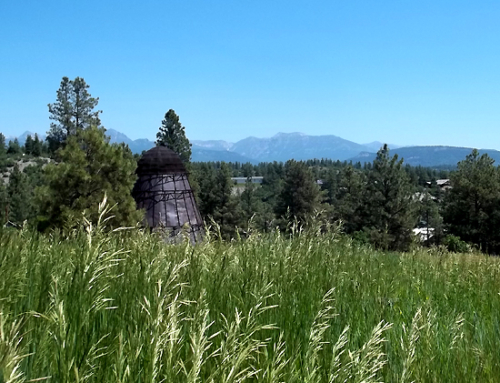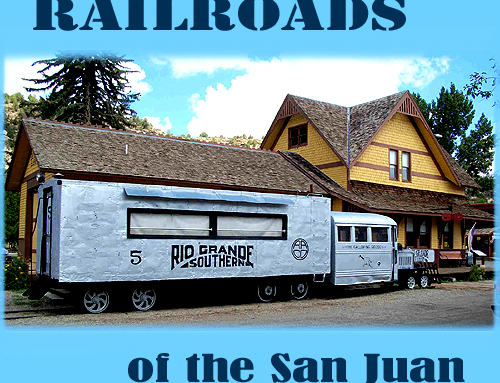The volcanism which formed the San Juan Mountains has settled over the centuries, but, as with the glaciers, signs of a fiery past remain. The layers of hardened tuff have weathered into fertile soils, lending to the thick vegetation covering the area today. Throughout the mountains and in the valley below, some parts of the continental plate are still worn thin. Magma still flows near the surface, heating the groundwater, which bubbles up in hot springs throughout the area.
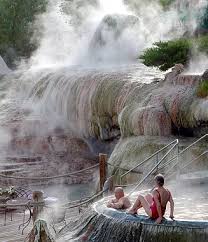 The town of Pagosa Springs was built on the largest of these springs. The spring has a high mineral content, mainly silica and hydrogen sulfide. The latter is responsible for a distinct odor which permeates the town. (If you’ve ever been through Glenwood Springs, you might have a hint… Pagosa is about twice as bad. If you haven’t, try leaving a dozen eggs in the sun for a week and add them to a steam bath. You’ll get the idea.) The silica in the water, which is visible as shining, floating flakes, collects as tufa.
The town of Pagosa Springs was built on the largest of these springs. The spring has a high mineral content, mainly silica and hydrogen sulfide. The latter is responsible for a distinct odor which permeates the town. (If you’ve ever been through Glenwood Springs, you might have a hint… Pagosa is about twice as bad. If you haven’t, try leaving a dozen eggs in the sun for a week and add them to a steam bath. You’ll get the idea.) The silica in the water, which is visible as shining, floating flakes, collects as tufa.
The term “tufa” is fairly ambiguous. The material forming the tufa mounds at Pagosa is not travertine, which is commonly associated with hot spring deposits. Travertine is calcareous sinter, similar to limestone. The tufa at Pagosa, on the other hand, is a siliceous sinter, a type of opal sometimes known as “gyserite”. The siliceous tufa mound at Pagosa springs, while now a part of a resort, was large enough to divert the course of the San Juan River. The mounds still grow today, although they’re now shaped by pipes and pools.
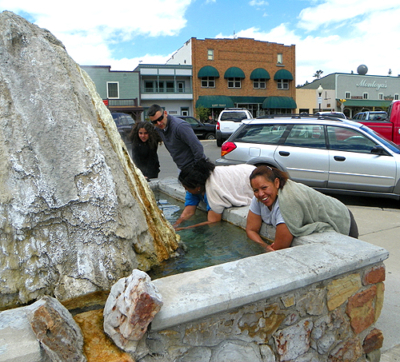 These ladies from Mexico came to Pagosa to find and soak in the hot spring. They reminded me of years past when the springs experience was completely different than now. Read along here and discover the past of The Great Pagosa Hot Spring.
These ladies from Mexico came to Pagosa to find and soak in the hot spring. They reminded me of years past when the springs experience was completely different than now. Read along here and discover the past of The Great Pagosa Hot Spring.
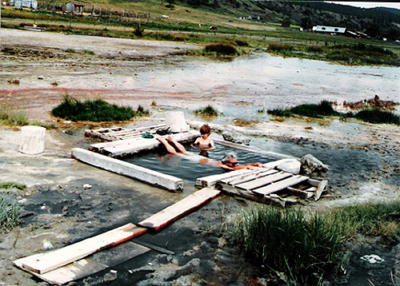
No one seemed to know when the “Hippy Dip” was first installed. At one time, late 1800’s to early 1900’s, many locals had their own little pool at the hot spring. Some were enclosed in small buildings and some of these were fancy, allowing privacy and comfort. Sunday afternoons were times of high social meetings for the county and visitors. The Hippy Dip may have been the last of the old pools.
It was as simple as it gets, a hole in the ground with no facilities and no charge! It was a hole dug about four feet deep and lined by eight foot long 6×6 inch railroad ties. I asked twenty years ago and no one could tell me how long it had been there. Some said there had always been a free dip someplace but weren’t for sure it was the same hole. Some said it was the last of the “dug in the ground tubs” from as long ago as the turn of the last century. It was private property but the owners were far away and it had historically been left open to the public. It was fed spring water by a separate small vent about thirty yards up a slight rise. The temperature was controlled by building dams in the stream, like little boys, and forcing a portion of the water to by-pass the pool. With no by-pass the pool became unbearably hot and took hours to cool down. It certainly had names before the “Hippy Dip,” given to it in the 1960’s-70, but none were recalled by the 1980’s. It was in the open field south of the main vent by a hundred yards or so. There was a rise in the land to the north so that, when in the tub, downtown could not be seen so the Pagosa Peak range was the view. Until the Best Western was expanded southward, the only close vestige of human occupation was the veterinarian office a half mile to the south, where Town Hall is now located and houses at a distance to the west. When Pagosa Springs was first established it was declared to be one square mile centered on the hot springs. So, although it was located at the absolute center of town, it was a private experience more like being in the wilderness. It was paradise.My family’s personal history was too many years living outside of but working in Dallas, Texas. Ruth and I both worked high pressure jobs in medical research at Southwestern Medical School. Mine was particularly stressful as I carried a beeper 24/7/365 for a dozen years and when it rang I was in for a couple of long days of high tension, working in the CCU with a fresh heart attack patient. I worked with high doses of radiation and became burned-up and burned-out in a big way. I turned grey and turned loose. We bought a small parcel of land south of Pagosa and five year old son, Ian and I moved here while Ruth finished out the six month time left on her grant at the medical school.As we started our house we found the “falls” below the dam at Echo Lake and used it for bathing for the summer. Soon we were told about the Hippy Dip. It was about fifty degrees warmer than Echo Falls and became a wonderful social and father and son bonding experience. We loved it and, as many others did at the time, it became our bath and rec center for several years. I also had a keen interest and learned a lot just listening to people and became part of the history by soaking there for a number of years.
The Hot Springs Underground
A wide variety of people came to this pool from a lady who parked a Mercedes Benz and took off a pile of jewelry before getting in to groups of tree planters who spent life bent over and came to soak away their pain. There were folks who were a part of a hot springs underground. They move about the country or world seeking out hot springs. They were purist and only went to free or donation supported springs. They sometimes knew each other by name and loved to compare notes on where they had been and bathed. They told great tales such as going 200 miles from the last pavement in Canada to a hot spring with mosquitoes as big as hummingbirds. Worth the trip? Oh, yeeessss!The Dip was different things to different people and this determined when you went to bathe. There were morning people, early afternoon people, late afternoon and getting off work people and night people. The nights were the rowdiest with A LOT of parties. It was on private property so the law didn’t bother anyone unless there was a compliant. It was so far from anyone that there were few to none. The morning people, cool and meditative, got to clean up the mess the night people couldn’t or didn’t want to see. The early afternoon people were quietly social while late afternoon brought construction workers, post a quick run by Pagosa Bar, and they were very talkative, and a bit louder.There was a code about the Dip’s use among the true spring people. Considering the sheer number of people that used the Dip and the fact that there was absolutely no one designated by the property owners to keep the area clean it was amazingly well kept and in nearly immaculate condition all of the time. The parties were cleaned up and people brought new railroad ties for the side walls, and wood planks and rocks as needed for landscaping. My young son Ian, sank and held his breath while going through the sandy floor with his hands, coming up with rings, other jewelry, mysterious stuff and coins. It was the coins he was after but hey, he did his part! There were many highly educated folks who soaked and conversations ranged the gamut of knowledge. Great oratory bored some and fascinated others and there were arguments that went on until one or the other turned into a prune and left. And then there were the characters and events that showed up or happened from time to time.There was an anthropoligist who showed up one day claiming he had followed the “signs” to the spring. He claimed there were ancient Indian signs across the southwest giving directions to Pagosa Springs.
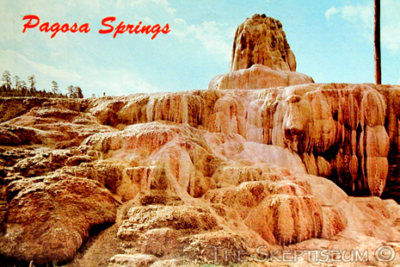 Dena, the Great Naked Psychic Lady from Wyoming.
Dena, the Great Naked Psychic Lady from Wyoming.
Dena was such a character. She was a psychic and hot spring fanatic; she even brought lithium water with her from her “favorite spring” because she heard The Great Pagosa was low on lithium. Lithium is used medically as an antidepressant, Dena drank it by the gallon. She began working with an alcoholics group here and claimed she was saving them all with her physic powers. Suits were optional at the Dip but locals tried to keep it quiet and low key. Dena made a BIG POINT of bathing naked by standing, jiggling and waving to people driving down Lightplant Road, now known as Hot Springs Blvd. She was size challenged, jiggled ALL OVER and couldn’t be subdued, charging that people were too up-tight. She may have impressed some with her psychic awareness but the only thing she couldn’t seem to foretell was when the sheriff was coming. She was taken to the county line and waved a “so long and good-by.
”The Day of the Bud Girls.Then there was the day three of the “Bud” cheerleaders came by the Dip and said, “We can’t get in that water with our pretty white Bud suits on!” They were instantly told of the lack of suit rules and soon it was birthday suits for all. There were no cell phones then, but guys amazingly started showing up in record numbers! Unfortunately, I was out of the “guy’s psychic network” so I missed it all, but it was discussed in great detail and at length for weeks.
Few locals knew the popularity of the Dip if they didn’t use it. It was easy to estimate, while in the Dip, that it was Pagosa’s number one tourist attraction. A continuous stream of people came year-round from near and far. There was no publicity other than word of mouth which was, evidently, very successful. Several people came year after year or often, when they could, and later bought property and became neighbors. I could name a few still here! During conversations I found that many came from places with hot springs or passed by hot springs on the way here, they swore by The Great Pagosa!
In autumn of 1988 a sacrilege occurred. The tradition of peace at the spring dip was shattered forever. Late at night a man and woman walked over to bathe; only he walked away. She was found floating face down the next morning. The details available are few and not to be exploited here, but it was murder at the Great Pagosa Hot Spring. The owners realized their liability problem and a large yellow machine arrived filling the Dip with rock and dirt. A tradition of perhaps 10,000 years of free access came to a halt. The Hippy Dip became one of those things too good to be true.Now, almost two decades later, I still miss the freedom and culture of the good souls who bathed there. Others miss it also, from time to time some of us “users” happen across each other and wave and lament about the “good old days.” We share a tradition and bond that will end with us.

